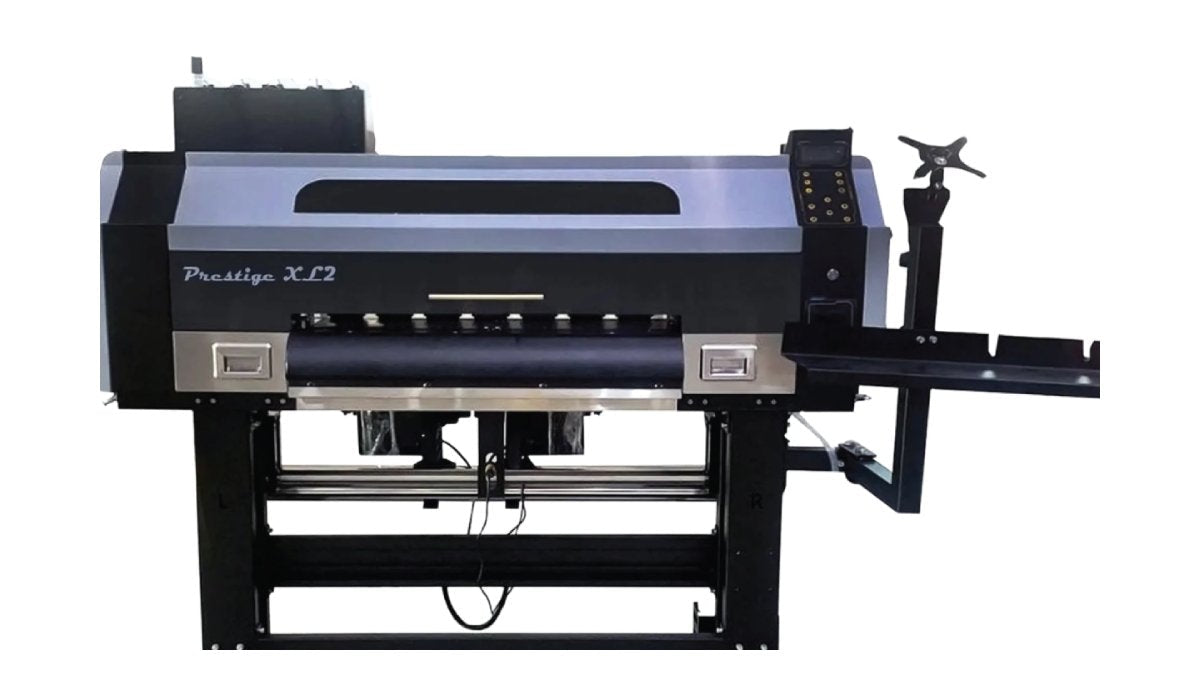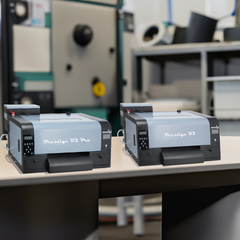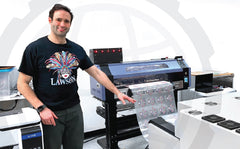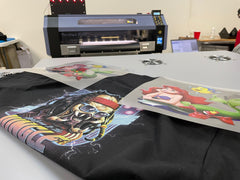The newest printing transfer technology, called “DTF” (short for direct-to-film), is revolutionizing the garment printing game. In the short time DTF has been on the market, early adopters have been creen printing, direct-to-garment (DTG) and vinyl printers. “The new DTF machines are unlike anything the screen printing industry has seen before,” says David Landesman, President of Lawson Screen & Digital Products.
What is DTF?
DTF printing is a quick and easy heat transfer process for low cost and high quality production. The basic steps include printing a design onto a special film, applying and melting a powder adhesive to the printed film, and pressing the printed film onto the garment using a heat press.
Depending on your scale and production needs, this process can either be highly manual (printing individual sheets and applying the powder by hand), or fully automatic (roll-to-roll printing with automatic powder application).
Why Consider a DTF Machine?
DTF technology promotes flexibility, customization, and efficiency. The benefits include:
- Color Variety. DTF transfers allow for printing unlimited colors without extra cost. You can make limitless color changes within a print, producing high-quality images that can include tiny details, gradients, and shading. DTF printing also requires less white ink than DTG printing, providing additional cost savings.
- Material Variety. DTF’s adaptability of application extends to all different types of materials, garments, and products. DTF transfers can be applied to cotton, nylon, treated leather, polyester, 50/50 blends, light and dark fabrics, shoes, luggage, glass, wood, metal, and the list goes on.
- Strength and durability. DTF transfers are remarkably durable. DTF prints wash and bend without peeling or cracking. Most DTF transfers will maintain a lightweight, soft hand feel while holding up to heavy use.
- Ease of use. DTF machines are easy to use, and DTF transfers are easy to apply. Heat is all that is needed for application. And the heat needed is at a lower temperature, reducing the risk of scorch marks and dye migration on polyester garments. Because the print is made onto a film transfer, which is then placed on the material, the design can be placed on a surface that might otherwise be challenging to reach using a traditional screen printing machine.
- No pretreatment or drying. Unlike DTG printing, DTF printing doesn’t require any pretreatment step, because the hot melt powder directly applies the image to the material. No additional time or equipment is needed for drying, either. This cuts down on production costs and time.
- Inventory options. You can print and store designs in advance, or print them on the spot, depending upon your business needs and demand.
How to Choose a DTF Machine?
Given the newness of the DTF market, it is especially important to look for a quality DTF machine from a reputable distributor. US based support is key since these printers are still new and require a little more work than a typical Epson DTG printer. You will also want to purchase a machine that includes ongoing personalized support with set-up, education, and maintenance, like that offered by Lawson Screen & Digital Products.
Lawson Screen & Digital Products offers a new line DTF printers, including the XL2 production printer and the desktop A3 and A3+R. Because DTF printing is the future, choose your equipment wisely and for the long-term.
How Should You Set up your Shop for DTF Printing?
To maximize print results, consistency, and safety throughout the DTF transfer process, ensure that your printing environment includes air filtration and adequate controls of climate, humidity, and static. Humidity actually benefits the transfer process by ensuring ink flow and preventing print head nozzles from getting clogged. You will want to make sure the environment is not too dry to avoid clogged print heads and printing inconsistencies.
What about supplies and artwork?
Once you have a DTF machine, the basic supplies needed for the DTF process are simply ink, transfer film, and adhesive powder. You may need to test various types of ink, film, and powder in different combinations to decide what works best for your business needs.
You will also need software that assists with creating and preparing artwork for printing. Making sure your color correction and matching is accurate can take some practice and training, but the first step is getting good software that will assist with the process.
For more information about DTF printing, reach out to Lawson Screen & Digital Products.




